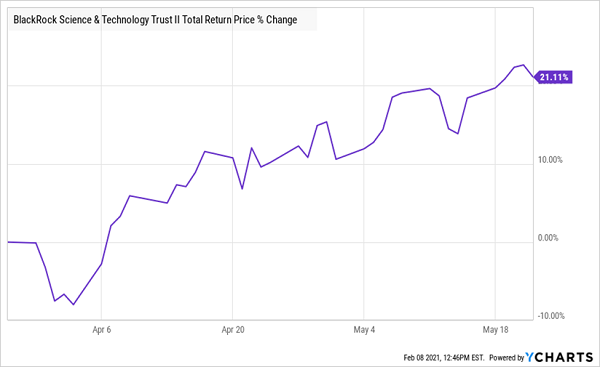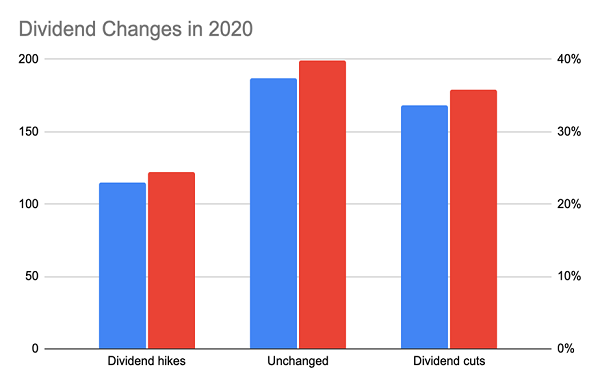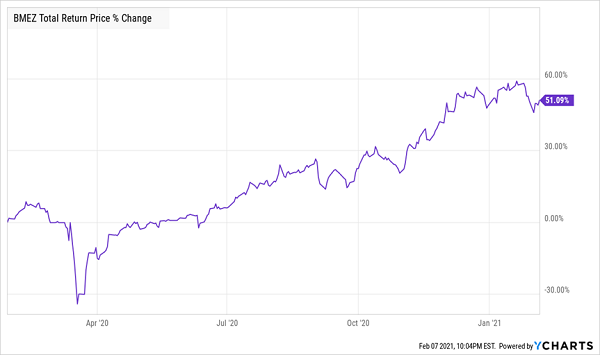A wild year like 2020 is a great acid test for closed-end funds (CEFs)—and it can tell us a lot about which of these high-yield plays to pick (and avoid!) as we move deeper into 2021.
A Split Market
If 2020 did anything, it widened the gap between winning and losing sectors of the stock (and closed-end fund) market. It just goes to show how critical it is to pick funds in the right sectors, as well as those with savvy management that can shift with the times.
Technology, of course, boomed last year. We were well-positioned in tech with the BlackRock (NYSE:BLK) Science and Technology Fund (NYSE:BST), which we added to our portfolio in August 2019. At the time, the fund, which focuses on large-cap tech stocks like Microsoft (NASDAQ:MSFT) and Amazon.com (NASDAQ:AMZN), paid a nice 5.5% dividend and had boosted its payout 50% in the preceding five years.
We then rode BST through the pandemic crash, selling on June 26, 2020 and picking up a nice 26% in gains and dividends in the process.
That wasn’t all: on March 27, 2020, right near the trough of the crash, we picked up BST’s sister fund, the BlackRock Science and Technology Trust II (NYSE:BSTZ), which yielded 7.3% at the time, and rode it to an even quicker return—21% over a two-month holding period.
Contrarian Tech Buy Paid Off Big in 2020
Even late-year tech gains were winners, like the Virtus AllianzGI Artificial Intelligence & Technology Opportunities Fund (NYSE:AIO): from our buy call in September till now, we’ve seen a 68% total return as of the time of this writing.
(For the record, I’m still bullish on tech CEFs, but we do need to be choosy, as many tech CEFs’ discounts to NAV—or the amount by which their market prices are discounted from their portfolio value—are narrower than they were a year ago, which could limit their upside in ’21.)
Of course, it’s just as important to avoid money-losing sectors as it is to pick winning ones. In the energy sector, the oil-price collapse caused many energy CEFs to simply shut down. The few that survived are paying dividends that are a shadow of what they used to be.
High Dividends Keep Growing
That brings us to dividends. CEFs’ high yields (around 6.5%, on average, as I write this) may make you worry about payout stability, but the truth is, several CEFs increased their dividends last year, despite the market turmoil. Overall, 24% of these funds hiked payouts, 40% kept them as-is, and 36% cut them.

Source: CEF Insider
The vast majority of the cuts were from energy funds. Hikes came from across the board, with equity-focused CEFs being big contributors. And a variety of funds of all stripes kept payouts unchanged.
The increase in payouts for many funds demonstrates how CEFs benefit income investors like us. Despite their high yields, these funds were able to increase payouts in a year when many low-yielding stocks, including some Dividend Aristocrats, cut theirs! The myth that one must choose high yield or dividend growth was (finally) discredited in 2020.
But we also had little to complain about from the funds that left payouts unchanged. CEFs as a whole still yield 4.5 times more than the typical S&P 500 stock. And some funds that left their dividends alone boast current yields north of 9%.
As a result of these high, safe and growing payouts, there is a lot more attention on CEFs than there has been in years.
CEFs’ Growth Signals It’s Time to Buy
One of the effects of this new-found attention is that the CEF market is growing and moving toward the mainstream. BlackRock, for example, launched a new CEF at the start of 2020, the Blackrock Health Sciences Trust II (NYSE:BMEZ), with a market cap above $2 billion.
Strong Showing from the Newcomer
Thanks to a strong bull run, BMEZ now has a $3.3-billion market cap, meaning this nearly brand-new fund is suddenly the fourth-largest CEF in the world. The sixth-largest, the aforementioned BSTZ, launched in 2019.
This era of big CEF IPOs is only getting started, as CEFs are winners for issuers (who can profit more from CEFs than from ETFs) and for investors (since CEFs provide higher income and, increasingly, superior returns to similar ETFs).
And none of this growth is coming at the expense of the biggest CEFs in the market. The biggest CEF out there, the Nuveen AMT-Free Quality Municipal Income Fund (NYSE:NEA), has over $4.5 billion in assets under management, and its total assets have been growing steadily for years, even after the pandemic-related selloff.
Big Fund Gets Bigger
NEA is a big fund, but it’s not the best. With many dividend cuts behind it, it isn’t my favorite municipal-bond fund, even if it has outperformed the index for many years.
This overall growth in the CEF market in a very turbulent period is a strong indicator that now is a good time to buy in. As CEFs attract more capital and grow in size, their discounts will shrink. It’s already happening: with a current average discount of 6.3%, these funds aren’t as cheap as they were before the pandemic, when they had a 7.8% discount to NAV.
Furthermore, since that discount spans the heavily discounted energy stocks, it’s misleading; take those out and the average is just 4%.

Source: CEF Insider
Clearly, market demand for CEFs is contributing to their price growth—and that means the sooner you can get into this growing asset class, the better.
Disclosure: Brett Owens and Michael Foster are contrarian income investors who look for undervalued stocks/funds across the U.S. markets. Click here to learn how to profit from their strategies in the latest report, "7 Great Dividend Growth Stocks for a Secure Retirement."
